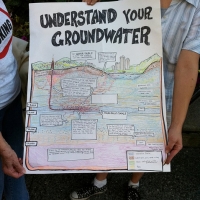20th May 2011.
Fans of MethaneNet’s Twitter feed will lately have seen plenty of references to ‘fracking’. This follows a study published in PNAS (1) in which methane contamination of groundwater is reported in northeastern Pennsylvania and upstate New York, in areas where gas is being extracted from underlying shales using directional drilling and hydraulic fracturing (fracking) technologies. The issue is relevant to UK-based readers as the first attempt at fracking shale to extract gas from rocks in England, operated by Cuadrilla Resources, got underway at Preese Hall Farm near Blackpool in March this year.
In the USA, the production of shale gas, deemed by its supporters to be a cheap, clean and relatively low carbon fuel, has increased dramatically in the past decade. Development of this ‘non-conventional gas’ source has not been without controversy. In 2010, a contentious US independent film ‘Gasland’, highlighted in emotive fashion what its director Josh Fox sees as the case against the shale gas industry.
The veracity of several of the more controversial scenes in Fox’s film, notably one in which tap water is set alight, have been disputed (2), but questions remain about the environmental impact of several aspects of shale gas exploitation.
The main concerns relate to the potential for leakage into drinking water aquifers, of gas from the wells and of the water/chemicals mix used to enhance the efficacy of the high pressure shale fracturing process. The study by Osborn et al. sought to establish some hard facts, amidst the controversy. The good news for supporters of shale gas production was that this study found no evidence that fracture fluids and chemicals had contaminated ground water supplies in the gas extraction areas studied. The bad news is that the researchers found methane concentrations were significantly elevated, up to 64 mg L-1 – a potential explosion hazard – within 800 m of the gas wells. Using the d13C –CH4 signature, the origin of the methane was shown to be thermogenic, i.e. associated with the shales, and not from an alternative biogenic source.
The study has been criticised by shale gas industry representative John Conrad (3) for not including baseline data, the suggestion being that the high gas levels measured may have pre-dated drilling of the shale-gas wells. The general consensus is that further work on the environmental impact of shale gas production – including the potential for increased methane emissions to the atmosphere – is badly needed. A report from the Tyndall Centre for Climate Change Research (4) went so far as to recommend a moratorium on exploitation of shale gas in the UK until more is known about the risks. Their conclusion is starkly at odds with the views of UK petroleum geologist Dick Selley of Imperial College, an enthusiastic proponent of UK shale gas production long before the idea became fashionable, who in this month’s Geological Society publication Geoscientist Online (2) continues to plead for a more rational debate about what he considers a much needed and environmentally benign additional energy source.
References
(1) Osborn, S.G., Vengosh, A., Warner, N.R. and Jackson, R.B. (2011). Methane contamination of drinking water accompanying gas-well drilling and hydraulic fracturing. PNAS Early Edition: www.pnas.org/cgi/doi/10.1073/pnas.1100682108.
(2) Selley, R. (2011). Shale Gas – blessing or curse? Geoscientist Online: www.geolsoc.org.uk/gsl/geoscientist/features/page9767/html
(3) Transcript of interview on National Public Radio on 13 May 2011: http://www.npr.org/2011/05/13/136280456/study-links-methane-in-water-to-gas-extraction
(4) Shale Gas – a provisional assessment of climate change and environmental impacts. A report by researchers at the Tyndall Centre, University of Manchester: http://www.tyndall.ac.uk/sites/default/files/coop_shale_gas_report_final_200111.pdf
